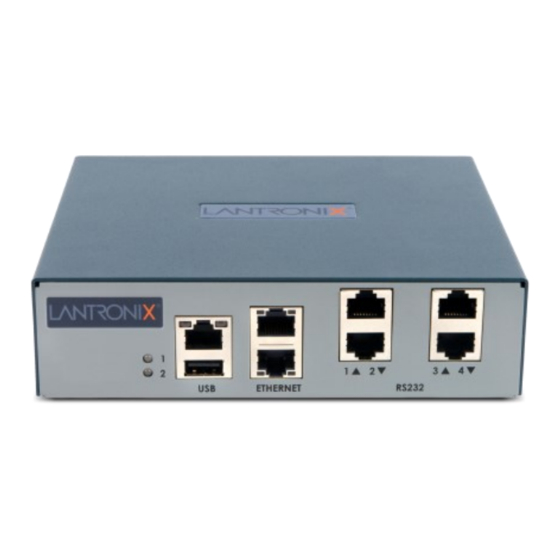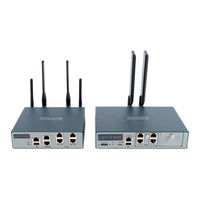
Lantronix EMG 7500 Manuals
Manuals and User Guides for Lantronix EMG 7500. We have 3 Lantronix EMG 7500 manuals available for free PDF download: User Manual, Quick Start Manual
Lantronix EMG 7500 User Manual (555 pages)
Edge Management Gateway
Table of Contents
-
Warranty2
-
Key Features25
-
Security26
-
Power26
-
Applications26
-
I/O Modules33
-
Power Input48
-
Power Input63
-
IP Address65
-
Next Step72
-
Web Manager74
-
Logging in76
-
Logging out77
-
Logging in77
-
Logging out78
-
Tips78
-
Requirements81
-
Gateway88
-
FQDN List97
-
Cellular Status103
-
Troubleshooting111
-
Ethernet Switch121
-
Port Statistics123
-
Switch Commands125
-
Vlans125
-
VLAN Commands126
-
Dhcp126
-
DHCP Commands129
-
IP Filter130
-
Mapping Rulesets130
-
Rule Parameters133
-
Routing135
-
Dynamic Routing135
-
Routing Commands137
-
Forwarding137
-
VPN Settings139
-
VPN Commands155
-
8: Services167
-
System Logging169
-
Audit Log169
-
Ssh170
-
Telnet170
-
Smtp171
-
Discovery Server172
-
SSH Commands172
-
Logging Commands172
-
Snmp172
-
Version 3177
-
V3 User Trap177
-
NFS and SMB/CIFS179
-
SMB/CIFS Share181
-
Browser Issues184
-
Date and Time188
-
Web Server191
-
Percepxion197
-
Manage Files207
-
Data Settings210
-
IP Settings210
-
USB Commands210
-
SD Card Commands210
-
10: Device Ports211
-
Permissions211
-
I/O Modules212
-
Device Status213
-
Device Ports213
-
IP Settings220
-
Data Settings221
-
Device Commands231
-
Local Logging233
-
NFS File Logging233
-
Syslog Logging234
-
Local Logging237
-
NFS File Logging237
-
Syslog Logging237
-
Logging Commands238
-
Console Port238
-
Internal Modem240
-
DIO Port244
-
DIO Commands245
-
Xmodem246
-
Xmodem Commands248
-
Host Lists249
-
Host Parameters249
-
Sites253
-
Site Commands255
-
Access Lists255
-
Dial in257
-
Dial-Back258
-
Dial-On-Demand259
-
CBCP Server260
-
CBCP Client261
-
Key Sequences261
-
Power Commands266
-
Devices - Rpms266
-
Rpms - Outlets277
-
RPM Commands280
-
12: Scripts281
-
Script Commands286
-
Primary Commands289
-
Example Scripts296
-
13: Connections315
-
Terminal Server315
-
Console Server317
-
User Rights324
-
Shortcut331
-
Nis332
-
NIS Commands334
-
Ldap335
-
LDAP Commands339
-
Radius340
-
RADIUS Commands343
-
Kerberos345
-
Tacacs348
-
TACACS+ Groups348
-
TACACS+ Commands352
-
Groups353
-
Group Commands356
-
SSH Keys357
-
Overview357
-
Imported Keys357
-
Exported Keys357
-
SSH Commands363
-
Custom Menus364
-
15: Maintenance367
-
Site Information373
-
EMG Firmware373
-
Manage Files377
-
System Logs378
Advertisement
Lantronix EMG 7500 User Manual (482 pages)
Edge Management Gateway
Table of Contents
-
Warranty2
-
Contacts2
-
-
Key Features24
-
Applications25
-
-
I/O Modules32
-
-
-
Power Input48
-
-
-
Power Input61
-
-
IP Address63
-
Next Step71
-
-
Web Manager72
-
-
-
Requirements79
-
-
DNS Servers85
-
Gateway86
-
IP Filter110
-
Routing115
-
Dynamic Routing115
-
Static Routing115
-
Routing Commands116
-
-
VPN Settings116
-
Security133
-
-
FQDN List146
-
-
8 : Services
147-
-
System Logging148
-
Audit Log149
-
Smtp149
-
Ssh149
-
Telnet150
-
SSH Commands151
-
Logging Commands151
-
-
Snmp151
-
Version 3154
-
V3 User Trap155
-
NFS and SMB/CIFS156
-
-
Browser Issues160
-
Date and Time164
-
Web Server166
-
Consoleflow171
-
-
Permissions182
-
I/O Modules183
-
Device Status184
-
Device Ports184
-
-
IP Settings191
-
Data Settings192
-
Device Commands202
-
-
Local Logging204
-
NFS File Logging204
-
Syslog Logging205
-
Local Logging208
-
NFS File Logging208
-
Syslog Logging208
-
Logging Commands209
-
-
Console Port209
-
DIO Port215
-
DIO Commands216
-
-
Xmodem217
-
Xmodem Commands219
-
-
Host Lists220
-
Sites224
-
-
Dial in227
-
Dial-Back227
-
Dial-On-Demand228
-
CBCP Server230
-
CBCP Client230
-
Key Sequences231
-
-
-
Devices - Rpms232
-
Rpms - Outlets242
-
-
RPM Commands245
-
-
-
12 : Scripts
246-
Script Commands251
-
Example Scripts261
-
13 : Connections
280-
-
Terminal Server280
-
Console Server282
-
-
-
-
User Rights289
-
Nis297
-
Ldap300
-
Radius305
-
Kerberos310
-
Tacacs313
-
Groups317
-
SSH Keys321
-
Custom Menus328
Advertisement
Advertisement


